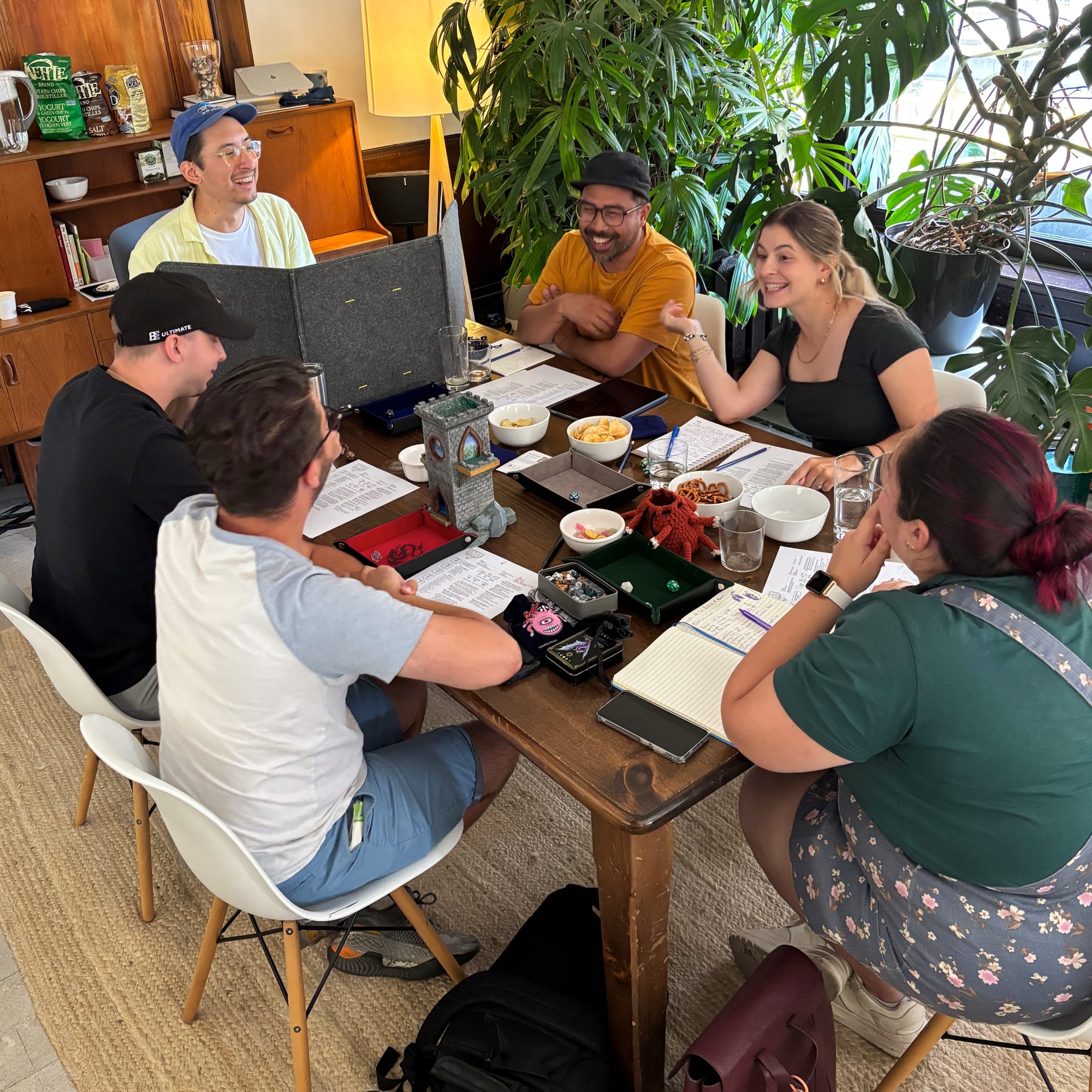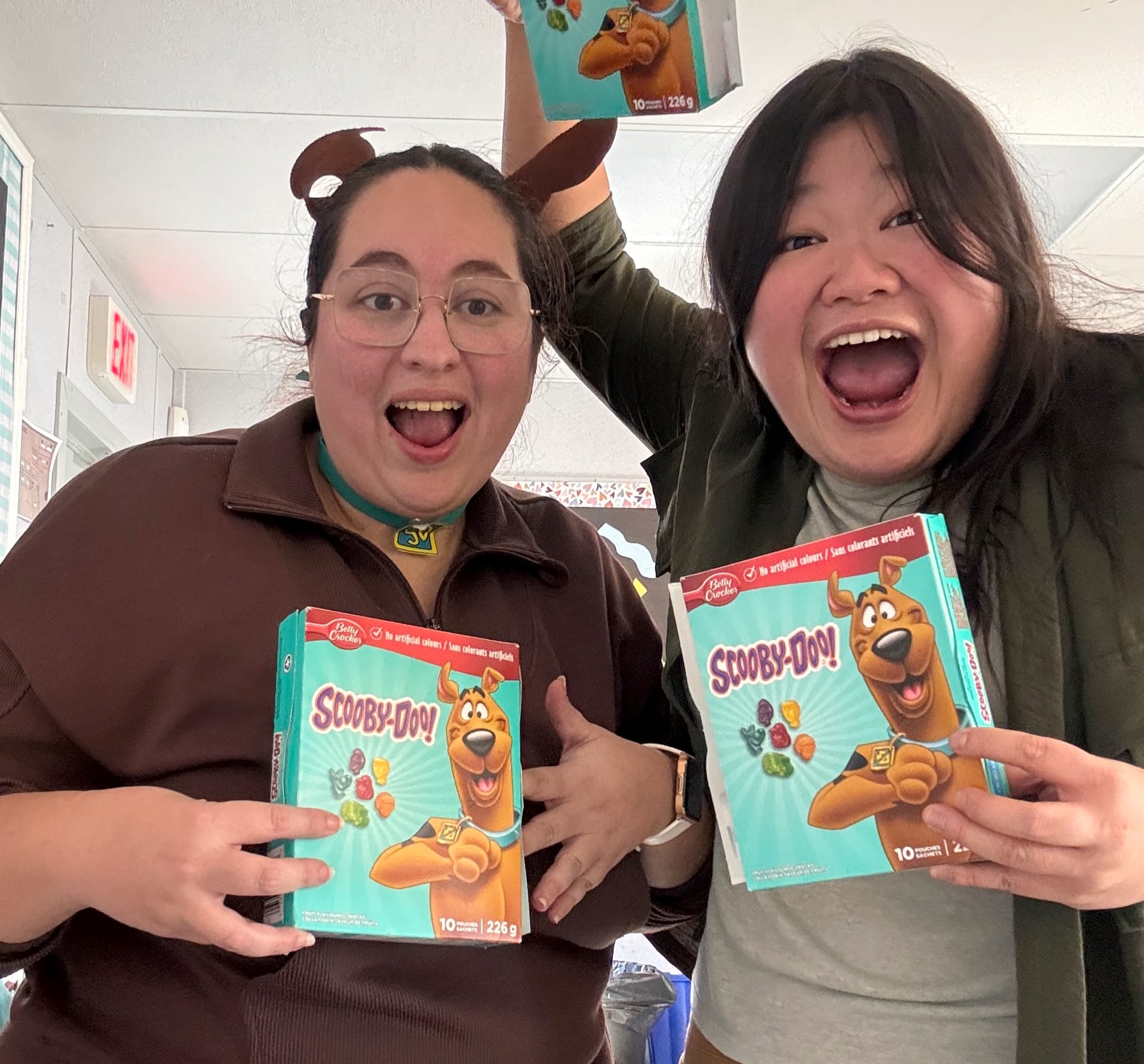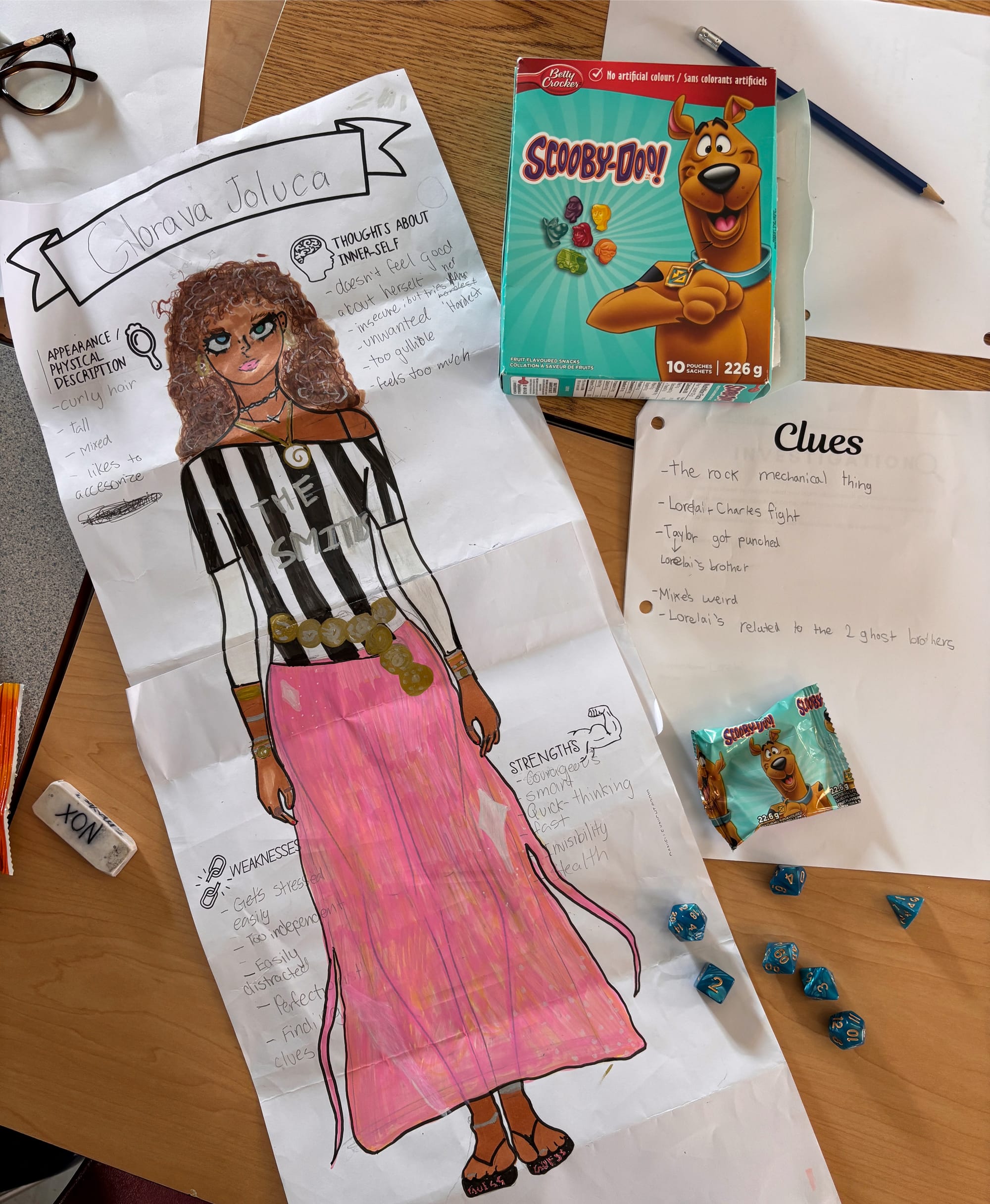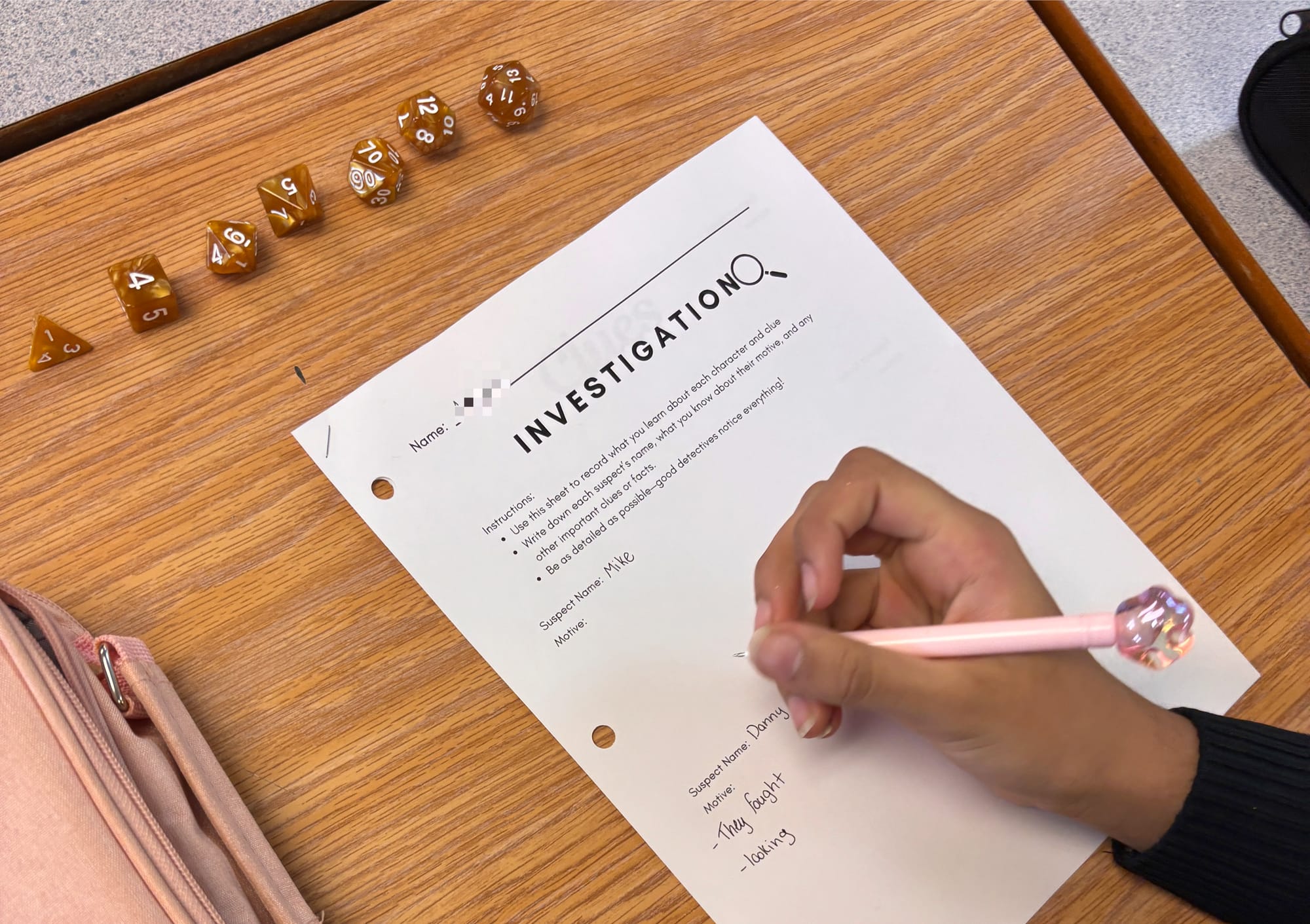During the summer, we hosted a Dungeons and Dragons day at our office. Five teachers, one chaotic one-shot, and Dylan as our enthusiastic Dungeon Master.
We’d been talking about doing something like this for a while. A few teachers we work with wanted to try D&D in their classrooms, and our team’s always up for a game. When we finally made it happen, we knew it’d be a blast! I didn’t play—someone had to take pictures and manage snacks—but watching it unfold had my mind spinning with potential classroom ideas.

Patricia was one of those dreaming teachers who joined us in the summer. She and I had been talking about a classroom D&D campaign since the beginning of last school year. At first, the idea was to try to bring it into her ancient civilizations unit. But that idea turned into board game project that you may recall from a previous volume. A huge success in its own right, but it didn’t scratch the D&D campaign itch.

Designing the Campaign ✍️
Fast forward and Patricia and I started brainstorming lesson ideas for an upcoming story writing unit. Role-playing games don’t exist without storytelling. We knew if we were going to embrace D&D, this was the time to do it.
Running a full D&D campaign felt like too much for a first try. So, instead we decided to start small. A single one-shot adventure, short enough for students to create characters, make choices, and see how dice rolls could shape a story. We knew this unit was going to happen the week of Halloween, so Patricia had the great idea to theme the adventure like a spooky Scooby Doo episode. It makes sense, the episodes are short, and there’s always a mystery the group solves together.
As we talked, Patricia kept circling back to D&D’s classic fantasy archetypes, which didn’t always match up with the tone and theme of a Scooby Doo cartoon. A Wizard, Barbarian and Druid chasing a ghost sounds, doesn’t really work! 🤔

The solution was sitting right in front of us, “What if the characters they built followed the archetypes of the Mystery Inc. Crew instead?”
- Fred — Strategic, Decisive, Brave, Driven, Leader, Strong
- Daphne — Resourceful, Charming, Optimistic, Empathetic, Adaptable, Persuasive
- Velma — Analytical, Curious, Rational, Observant, Intelligent, Perceptive
- Shaggy — Reluctant, Cautious, Funny, Loyal, Anxious
- Scooby — Loyal, Innocent, Playful, Faithful, Kind Hearted
These were the traits the class ended up focusing on while developing their own characters. They were super impressive! They drew up character sheets, identified their strengths and weaknesses, and most even had well thought out backstories.


Character sheets included individual traits, and fashionable outfits, of course.
For simplicity’s sake, each group of four or five students shared control of one character. Unlike a typical D&D campaign—where choices can spiral in every direction—Patricia gave them a few clear options to pick from, more like a choose-your-own-adventure story. It kept the pacing tight and the plot moving forward. Still, the D20 had the final say on how well each group’s moves played out.
Running the Game 🎭

When the one-shot began, Patricia transformed her classroom: background music, a soundboard, a projected backdrop, and voices for every NPC—including a sudden southern accent that greeted the students with a natural drawl when the Owner of the Manor showed up.
Her performance was getting so much attention that other teachers (and the school principal) had heard what was happening and took turns showing up to watch the Grade 7 class!
A thunderclap used to great effect!
Of course, there was one instance where a group rolled a natural 20! With such a critical success, Patricia let the group make an open-ended decision for their character to act on. No options, "you tell me what you want to do!"
They chose to punch a monster in the face. Classic. 😅
Turns out, the monster was actually the brother of the character that hired the group to investigate! They were kicked out of the house they were investigating, and sent in a completely unexpected direction. They walked right into a classic Scooby-Doo trope! A great example of being flexible with the rules to help tell an awesome story.
This kind of tweaking continued throughout the campaign. As things shifted in the story, Patricia would adjust on the fly. At one point, she realized that having groups use the highest roll of five dice was too overpowered! Instead, she switched them to roll one dice for the group. Character failures are just as fun as successes, as we just learned!


A crowded climax and dedicated note taking.
Students were so into it. They were debating theories, whispering strategies, all while completely forgetting they were technically in an ELA class.
One of the trickiest parts, Patricia said, was reminding each table that they were controlling a single character, not the whole party, and that they needed to coordinate with other player groups before charging ahead. It took awhile for them to get the hang of listening, debating, and making joint decisions. Something even I struggled with the first time I played a D&D campaign.
By the end, though, you could see their teamwork growing as they started consulting nearby tables and planning together. Managing that level of collaboration in a big classroom is no small task, but Patricia handled it like a seasoned Dungeon Master.
Connecting the Dots 🔄
So, are role-playing games a useful way to teach storytelling? What's next?
Here’s what Patricia said about her experience teaching the class.
“Table Top Role-Playing Games (TTRPG) are a useful way to teach storytelling because they engage students differently. They aren’t just hearing a story—they’re part of it, seeing how their choices affect the outcome. The dice rolls build tension and add to the conflict.
Students also get to explore characters on a deeper level. They make choices based on what the character would do rather than what they would do themselves, which helps them see a different perspective.
Working in groups encouraged them to discuss their choices and really think about how their characters think and act. It also helped them understand how characterization works—how a character’s actions, words, and reactions reveal who they are.
It was also the most fun I’ve had teaching storytelling.”
Next, her students will turn that energy toward writing their own one-shot style stories.
"Being the one who shapes the story and builds a place for their friends to enjoy is great motivation for them. The class already asked if we can play a game every week!
Next, I'll have them create a story with two different endings based around a character choice. After they've written their stories I'll encourage them to turn them into games on their own. Perhaps one day, we'll play through them as a class."
You won’t want to miss it.
What's happening here?! 🐙
Things got pretty wild during our teacher D&D one-shot. Mika, one of the teachers, drew this moment from the day’s silliest encounter—can you tell what’s going on?


